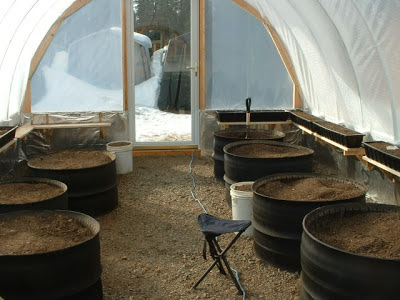By Mary Hinckley, an Alaska Master Gardener in Tok, Alaska
Several years ago on a trip Outside, Snooks and I discovered Andean Fingerling potatoes. Up until then we’d become increasingly disappointed in grocery store potatoes. They seemed to have lost their savor, containing
only starch and no flavor. We agreed that they were more like filler than food. But in a health food store we discovered potatoes called ‘Red Ruby Crescent.’ Brand new to us, we decided to give them a try and paid the outlandish price of five dollars for a two-pound bag. We boiled them up for dinner and liked them so much that if the store had still been
open, we’d have gone back for more. Delicious, like the potatoes of old, they were thick, smooth, creamy and with added butter, superb. We revised our opinions about potatoes right then and vowed to grow fingerlings.
At the time we were in our motor home in southern Missouri and our garden consisted of several 5-gallon buckets. We started the potatoes in one of these pails, on a small layer of dirt. We covered them with more dirt and watered. As the plants grew we kept covering them with dirt and paid attention to water. It was quite hot in Missouri and although our tomato crop flourished, heat may have been the reason our potatoes never got very big. Fingerlings are small to begin with, but these looked more like the bullets than potatoes. We decided to try again when we got back to Alaska.
Once back home, Snooks developed a growing process that was so successful with potatoes that we decided to use it for all our greenhouse crops as well. First, he starts with regular old tires. Any kind of tire will do and we
use different ones for different things, but for potatoes we use the largest tire we can. First he cuts out the sides of the tire. Then the gorillas come in to help turn it inside out, but it doesn’t really take great strength or gorillas as turning gets easier once you develop your technique. Once the tire is turned inside out we have a planter, a tater tire!
 |
| Tires ready to plant. Photo by Mary Hinckley. |
We wash the tater tire off and place it in the garden. A layer of fresh dirt is set in and seed fingerlings on top of that. The seed potatoes are covered with more dirt and watered. As the plants grow the process is repeated We make sure enough of both is added. The plants are watered even more once they flower.
The potatoes are ready to harvest when the plants start to die, usually after the frost. We cut them off at ground level. Now the tater tires really come in handy; all we do is flip them over. No digging, just hunting, gathering and brushing off the dirt. Each tire yielded 10-15 pounds of potatoes. We reserve the biggest ones for next year’s planting and bag the bulk of the harvest to store under our house for winter use.
 |
| Fingerling potatoes. Photo by Heidi Rader. |
‘Red Ruby Crescent’
potatoes were a great discovery for us and as they are an Andean potato, they
adapt very well to our Alaskan climate. We’ve grown other fingerlings here but have
found our favorite to grow and eat is the ‘Red Ruby Crescent.’ Another reason the
discovery was so good was because it resulted in the development of tater tires.
They have proven to be very good planters. Though the Andean potatoes like
cooler conditions than in Missouri, our cool, Tok spring was too harsh for the
crops of some other potato farmers here. But our black, tater tires drew heat
and kept our potatoes comfortable enough to grow.
We also use tater tires in our greenhouse. The inside planters consist of two stacked tires. In the bottom one Snooks puts fresh horse manure and above he puts our soil, a mixture of Tok dirt and aged horse manure. As the early, spring sun hits the greenhouse the tires heat up, more heat is generated by the manure so the soil in the top tire gets even warmer. So far, by incorporating this stacked system into our insulated greenhouse we’ve extended our growing season by more than a month.
Share this.

